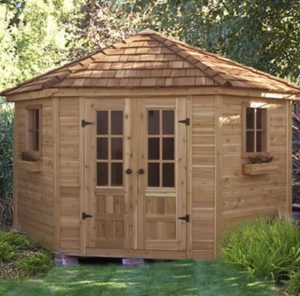The five-sided Walmart tiny home boasts that it acts “as much more than a shed.”
The company doesn’t explicitly say the tiny home is livable – instead, it offers the structure as a backyard retreat or a second dining room.
Home buyers that are looking to make the dwelling a permanent structure will run into two problems with the home.
The exterior is covered by cedar wood – a solid repellant for mold and pests.
But the wood creates an aesthetic challenge.
“Over time, unfinished cedar left outdoors will weather to a silvery gray patina,” the company says on the website.
The structure also doesn’t come built.
Walmart says that customers must put the structure together, and the project may take an entire weekend.
The shed has twin front doors and two windows, complete with window boxes.
The windows come complete with a functioning screen to keep pests out of the home.
Tiny homes have become a popular anti-inflation housing solution for home buyers looking to undercut the cost of living crisis.
POPULARITY OF TINY HOMES
The average American spends just over $2,000 a month in rent, according to Redfin.
Multiple tiny home owners have reported spending far less than the average home buyers.
One TikToker claims she spends $1,149 monthly living out of her van.
The price is minuscule compared to apartment prices in major cities.

Another family of four took to TikTok to explain how living in an RV costs them just $500 a month.
Some tiny homes have even gone on to make large profits.
One family reported turning a $30,000 Home Depot shed into a $400,000 home.
Tiny homes have some legal hurdles despite their potential savings.
TINY HOME, BIG PROBLEMS
Depending on the jurisdiction, some tiny homeowners may need help with where they place their homes.
The U.S. Sun spoke with Judy Dutton, Realtor’s executive director, about legal troubles tiny homes present.
“Probably the biggest catch is you can’t just plunk down a tiny house anywhere,” Dutton said.
Dutton said that state an local regulations will decide how easy it is for buyers to live inside their tiny homes.
She pointed to homes on wheels as an example of legal issues in different jurisdictions.
“A tiny house on wheels is nice if you want to move often and enjoy a change in scenery,” she said.
But, she pointed to different city-level laws that explicitly specify that homes on wheels are not recognized as permanent dwellings.
























